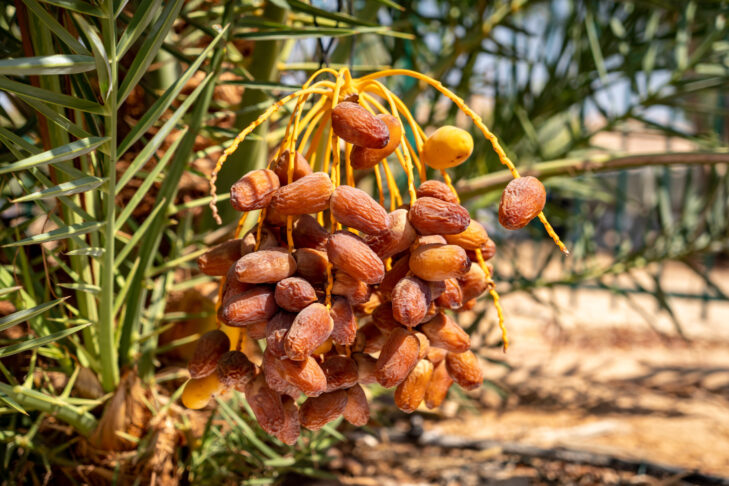There’s a piece of Jewish lore that pointedly teaches the importance of planting a tree. The story attributed to Rabbi Yochanan ben Zakkai, who lived in Jerusalem during the destruction of the Second Temple, emphasizes that if one is planting a sapling as the Messiah is arriving, plant the sapling first and then go out to greet the Messiah.
That story has particular resonance on Tu BiShvat, a holiday that traditionally celebrates trees, nature and the beginning of the planting season in Israel. The holiday is also an occasion to consider ecology in general. Shades of Yochanan ben Zakkai’s aphorism are embedded in the mission and activities of The Arava Institute for Environmental Studies, located at Kibbutz Ketura in the Negev desert.
Celebrating its 25th anniversary this year, the institute was recently in the news for successfully growing dates from a 2,000-year-old seed originally found on Masada. Miriam May, chief executive officer of the Boston-based Friends of the Arava Institute, told JewishBoston that the institute’s scientists “employed a combination of chemistry and wisdom to make the seeds bloom, and were successful with a tree called Methuselah.”
However, there was a catch: Named for the oldest man mentioned in the Bible, Methuselah was a male tree and could not flower independently. Enter Hannah, a female tree whose seed came from Jericho in the West Bank. Carbon dating determined that Hannah’s seed originated between the first and fourth centuries BCE. After six years in a flowerpot on Ketura, Hannah flowered and was ready to be brushed with Methuselah’s pollen. This arboreal matchmaking yielded dates last September that May described as having a rich, caramel flavor.

The creative botany leading to these ancient dates blooming is part of what May calls “environmental diplomacy.” The term is part of the institute’s ongoing mandate to bring Israelis, Palestinians, Jordanians and students of other nations to the institute to study various ecosystems. Its research centers on issues of water management, sustainable agriculture, renewable energy, the socioeconomics of desert ecology and other related topics.
The institute was founded in 1996 in the wake of the Oslo Accords. From the beginning, ecological research, including the biodiversity of the Arava Valley, went hand-in-hand with appreciating the region’s multiculturalism. After the Second Intifada, it also became apparent that there needed to be a dedicated effort to help students speak to one another about difficult subjects. Help arrived in the form of the Peace Building and Leadership Seminar, which May said “allowed people to talk about gender, politics, the occupation—all the difficult topics—through an environmental lens. The participants learned to listen to each other, to speak to each other politely. They learned to live together.”
These past 25 years at the institute have also seen the formation of a robust network of graduates, an offshoot of the organization’s dedication to practice environmental diplomacy. May said that just as “nature knows no borders, so too do the institute’s alumni comfortably cross psychological and physical borders.” Coupled with the practicalities of job searching or couch surfing on their various travels, alumni “are so good to each other, and on a cross-border basis, on a global basis, they see each other as a network. Some of them have gone on to prominent positions in Israel, Jordan and Palestine.”
Partnerships with other academic institutions have also boosted the alumni network’s global reach. One example is the institute’s collaboration with Oxford Martin School at Oxford University on measuring climate change across borders in the Middle East and beyond. “We see our partnership with Oxford Martin as going from strength to strength on climate change,” May said.

In Boston, the institute is collaborating with Northeastern University to offer a certificate program covering various units on desert ecology with a focus on careers and the environment in general. May noted that institute alumni have been key to the Northeastern program’s success. “We were able to recruit one lawyer who was with the Environmental Protection Agency and another environmental lawyer based in Los Angeles to contribute their expertise,” she said.
The institute is also exporting its knowledge in areas such as water management. “Israel is brilliant at conserving and reusing water,” said May. She noted that 84% of the water in Israel is reused. The number is impressive given that Spain has the next-highest percentage at just 19%. “One of the goals,” noted May, “is to act on water agreements already in place with Jordan and to help them reuse up to 30% of its water. It is in Israel’s best interest to have peaceful neighbors with enough water to drink. It’s also a basic human right to have clean water, whether you’re in Gaza or the West Bank. Cooperating with the Israel Defense Forces, we have brought clean water to a hospital in Gaza.”
In addition to working with the Israel Defense Forces, the institute has partnered with Jewish National Fund on global initiatives to bring more technology to Africa and South America. To that end, the institute has a long-standing clean water project in Kenya. May reported that the goal in Kenya is to use technology in wastewater treatment for effective agricultural outcomes.
As for future endeavors, May said the institute’s work will continue to flow from the ongoing and enduring precept that “nature knows no borders, and that we live those words in how we work with students and how we implement environmental diplomacy across relationships in the Middle East.”



